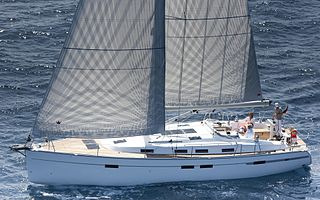
A yacht is a sail- or motor-propelled watercraft made for pleasure, cruising, or racing. There is no standard definition, though the term generally applies to vessels with a cabin intended for overnight use. To be termed a yacht, as opposed to a boat, such a pleasure vessel is likely to be at least 33 feet (10 m) in length and may have been judged to have good aesthetic qualities.

A jetboat is a boat propelled by a jet of water ejected from the back of the craft. Unlike a powerboat or motorboat that uses an external propeller in the water below or behind the boat, a jetboat draws the water from under the boat through an intake and into a pump-jet inside the boat, before expelling it through a nozzle at the stern.

A catamaran is a watercraft with two parallel hulls of equal size. The wide distance between a catamaran's hulls imparts stability through resistance to rolling and overturning; no ballast is required. Catamarans typically have less hull volume, smaller displacement, and shallower draft (draught) than monohulls of comparable length. The two hulls combined also often have a smaller hydrodynamic resistance than comparable monohulls, requiring less propulsive power from either sails or motors. The catamaran's wider stance on the water can reduce both heeling and wave-induced motion, as compared with a monohull, and can give reduced wakes.
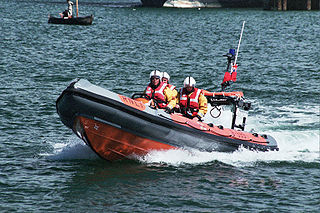
A rigid inflatable boat (RIB), also rigid-hull inflatable boat or rigid-hulled inflatable boat (RHIB), is a lightweight but high-performance and high-capacity boat constructed with a rigid hull bottom joined to side-forming air tubes that are inflated with air to a high pressure so as to give the sides resilient rigidity along the boat's topsides. The design is stable, light, fast and seaworthy. The inflated collar acts as a life jacket, ensuring that the vessel retains its buoyancy, even if the boat is taking on water. The RIB is an evolutionary development of the inflatable boat with a rubberized fabric bottom that is stiffened with flat boards within the collar to form the deck or floor of the boat.

The K-class ferries are a group of similarly designed ferries operated by both BC Ferries and TransLink in British Columbia, Canada.

HMNZS Canterbury is a multi-role vessel (MRV) of the Royal New Zealand Navy. She was commissioned in June 2007, and is the second ship of the Royal New Zealand Navy to carry the name. She is also New Zealand's first purpose-built strategic sealift ship.

The Greycliffe disaster occurred in Sydney Harbour (Australia) on 3 November 1927 when the harbour ferry Greycliffe and the Union Steamship Company mail steamer Tahiti collided. The smaller ferry was cut in two and sank with the loss of 40 lives, the deadliest incident on Sydney Harbour.
A rescue lifeboat is a boat rescue craft which is used to attend a vessel in distress, or its survivors, to rescue crew and passengers. It can be hand pulled, sail powered or powered by an engine. Lifeboats may be rigid, inflatable or rigid-inflatable combination-hulled vessels.
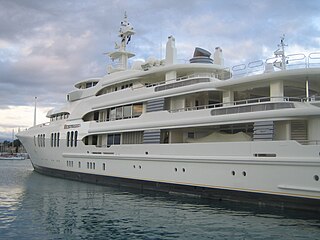
Ecstasea is a luxury yacht, the biggest Feadship built when she was launched. In June 2009 she was sold by her original owner, the Russian oligarch Roman Abramovich, to Alshair Fiyaz by yacht brokers Merle Wood.
BRP Simeon Castro (PC-374) is the fourth ship of the Jose Andrada-class coastal patrol boats of the Philippine Navy. It is part of the first batch of its class ordered through US Foreign Military Sales (FMS) in 1989, and was commissioned with the Philippine Navy on 24 June 1991. It was initially designated as Fast Patrol Craft, and was numbered "DF-374", but later on was re-designated as a Patrol Gunboat, and was re-numbered as "PG-374", until another round of reclassification changed its designation as a Patrol Craft with hull number "PC-374" from April 2016.
BRP Nestor Reinoso (PC-380) is the tenth ship of the Jose Andrada class coastal patrol boats of the Philippine Navy. It is part of the second batch of its class ordered through US Foreign Military Sales (FMS) in 1993, and was commissioned with the Philippine Navy on 1 June 1995.

Wilhelm Carpelan is a former Von Fersen-class transport boat. Built in 1915 for the Imperial Russian Navy, she was used as a transport boat and later a minesweeper by the Finnish Navy until 1977. After decommissioning, she was sold to private ownership and used as a pleasure boat. In 2013, Wilhelm Carpelan was donated to the collections of Forum Marinum, the maritime museum in Turku, Finland.
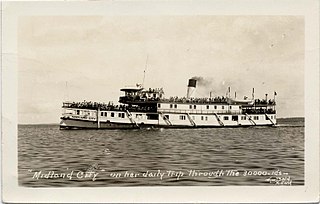
SS Midland City was originally a Canadian side-wheel steamboat that provided passenger and cargo transportation on the Great Lakes from 1871 until 1955. Originally named Maud, then America, she underwent several extensive refits over her 84-year service, and saw several owners. The ship was intentionally run aground and burnt to the waterline in 1955 near the mouth of the Wye River in Midland Bay. The wreck is intact and visible above the water to this day, where it acts as a breakwater for the Wye Heritage Marina and local attraction.

Karrabee was a ferry operated by Sydney Ferries Limited and its NSW State Government operated successors on Sydney Harbour from 1913 until 1984. A wooden ferry built at the time of Sydney Ferries' rapid early twentieth century, she and near "sister", Karingal, were the smallest of the fleet of round-end "K-class ferries".

W:m Crichton & C:o Ab is a former engineering and shipbuilding company that operated in Turku, Grand Duchy of Finland in 1842–1913. The company also had another shipyard in Okhta, Saint Petersburg.
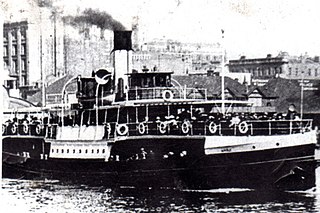
Manly (II) was a ferry that served on the Sydney to Manly run from 1896 to 1924.

Kameruka and Kamiri were near identical ferries that served on Sydney Harbour. Kamiri was built in 1912 and Kameruka was launched on 8 February 1913. They were double-ended "K-class" steam ferries, a type that was prolific on Sydney Harbour in the early 20th century boom in cross-Sydney Harbour ferry transport before the 1932 opening of the Sydney Harbour Bridge. Kamiri was laid up in 1951 following the New South Wales government take-over of the Sydney Ferries Limited. Kameruka was converted to diesel in 1954 and was laid up in 1984.

Kareela was a "K-class" ferry on Sydney Harbour. Launched in 1905, the double-ended timber-hulled steamer was built for Sydney Ferries Limited in response to the early twentieth century boom in cross-harbour ferry travel prior to the opening of the Sydney Harbour Bridge. She was the first of Sydney Ferries Limited's boats to have a fully enclosed upper deck.

Splinter fleet or Splinter navy was a nickname given to the United States wooden boats used in World War II. The boats served in many different roles during the war. These boats were built in small boatyards on the West coast and East coast, Great Lakes and the Gulf of Mexico. They could be built quickly, in just 60 to 120 days. Most of the boats were built by boatyards that already had the tools and knowledge from building yachts, sailboats and motor boats. Many were built by craftsmen in family-owned small businesses. Under the Emergency Shipbuilding Program and War Shipping Administration contracts went out to over fifty boatyards across the country. The boats were built for the US Navy, the United States Army Air Forces, United States Coast Guard, and US Army. Some of the wooden boats went to Allied nations on the Lend-Lease program.

Kaludah was a K-class ferry on Sydney Harbour, Australia. Commissioned in 1909, the timber-hulled steamer was built for Sydney Ferries Limited during the boom in cross-harbour ferry travel prior to the 1932 opening of the Sydney Harbour Bridge. Like the other "K-class" ferries, she was double-deck, double-ended, steam-powered screw ferry. However, she and the larger but otherwise similar Kookooburra (1907), were the only two K-class ferries designed by naval architect Walter Reeks and not Sydney Ferries Limited's Captain Summerbell.

















